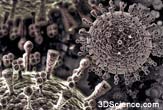Love and Sex Influence Disease Evolution

Dating, going steady, hooking up, settling down. There are many ways to be a couple and avoid the lovesick blues. Now it appears that in addition to lovesickness, there is a link between the types of relationships people have and how illness affect us all.
In a study of sexually transmitted diseases, scientists have concluded that the length of time people stay together can determine which infectious diseases circulate in a community and therefore how diseases evolve multiple strains.
Up to now, studies looking at how disease travels in groups worked with models that assumed people bump into each other at random, on a crowded street or some other public place. One disease strain could then hop easily from host to host until maximum infection was achieved.
In reality, of course, our interactions are more complicated. Some people have one long-term partner, while others come in contact with many people, each only for a short time.
How diseases spread
Many diseases spread by viruses, which are constantly morphing to better infect their hosts—in this case, us. So how we interact with each other is important to how a disease changes and adapts.
Since not all people act similarly, what seems to happen is that different strains, or types, of a single disease develop to suit our various behaviors. Some strains are better at infecting people in monogamous relationships, while others are better at infecting people with many short partnerships, according to a study in this month’s issue of the American Naturalist.
Get the world’s most fascinating discoveries delivered straight to your inbox.
Highly infectious strains, which take hold in the body for long periods of time, do well in monogamous pairings, where there is little chance a new host will come along any time soon. On the other hand, highly transmissible strains are better adapted to infect people with frequent, short-term relationships.
This is the first time that one specific aspect of human behavior can explain why different strains coexist, said Ken Eames, a coauther of the study from the University of Warwick. It also explains how two different strains of a same disease can occur in a population without one driving the other to extinction by infecting all possible hosts.
Broader implications
Though the new model can be easily applied to sexually transmitted diseases, Eames says the findings extend more broadly.
“It's an issue for all sorts of diseases, many infections are spread through social contacts in a household or an office, for example, and those contacts also tend to be longlasting,” Eames said.
"Just think of the behavioral differences between village and city life: one with quiet streets and few new faces, and the other with thousands of hurrying people and crowded public transport," Eames said. "That's two very different environments for a pathogen. There are always going to be plenty of factors that determine which strains emerge, but human mixing behavior has a big part to play."


